One of Python’s many strengths is its built-in support for handling data structures such as dictionaries.
Dictionaries in Python are key-value pairs that enable efficient data storage and retrieval, and you’ll often need to combine or merge dictionaries in various scenarios.
To merge dictionaries in Python, you can use the update() method, dictionary comprehension, or the recently added “merge” operator (Python 3.9 and later). The update() method adds the key-value pairs from the second dictionary into the first, modifying the first dictionary. If duplicate keys exist, the last value will overwrite earlier ones.
In the following sections, we’ll explore these methods in detail, learn how to use them, and investigate their pros and cons. This will help you choose the right approach for your specific needs.
Let’s jump in!
Basics of Dictionaries in Python

Before we start merging dictionaries in Python, let’s quickly review the basics of dictionaries.
1. Dictionary Data Structure
Dictionaries in Python are versatile and efficient data structures that store key-value pairs, where each key maps to a value.
Here’s an example of a dictionary:
person = {'name': 'Alice', 'age': 30, 'city': 'New York'}2. Keys and Values
- Keys are unique identifiers within the dictionary and are used to access the associated values.
- Values can be any Python object, including strings, numbers, lists, and other dictionaries or custom objects.
Accessing a value in a dictionary is easy and efficient. You can use the same key in square brackets or the get() method:
name = person['name'] # 'Alice'
age = person.get('age') # 307 Ways to Merge Dictionaries in Python
In this section, we’ll look at 7 methods of merging dictionaries in Python:
- Merging Dictionaries With the Update Method
- Merging Dictionaries With Dict Constructor
- Merging Dictionaries With the Unpacking Operator
- Merging Dictionaries With the Merge Operator
- Merging Dictionaries With Dictionary Comprehension
- Merging Dictionaries With ChainMap
- Using Functions for Merging
1. How to Merge Dictionaries With the Update Method
The update() method is a popular technique for merging dictionaries in Python.
This method simply iterates through the keys and values of a dictionary and adds them to another dictionary.
If a key already exists, its value will be replaced with the new value.
The following is an example of merging dictionaries in Python with the update() method:
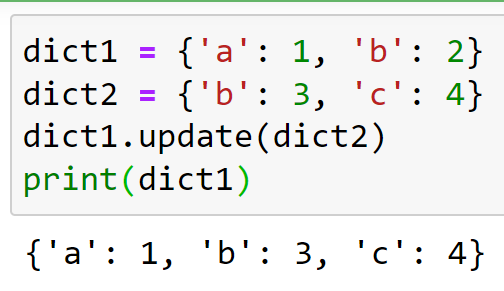
Notice that the value of key ‘b’ in dict1 has been replaced with the value from dict2.
The update() method modifies the original dictionary, so keep that in mind when performing this operation.
2. How to Merge Dictionaries With Dict() Constructor
Another way to merge dictionaries in Python is by using the dict() constructor.
This method creates a new dictionary containing key-value pairs from both input dictionaries.
The following is an example of merging dictionaries with the dict() constructor:
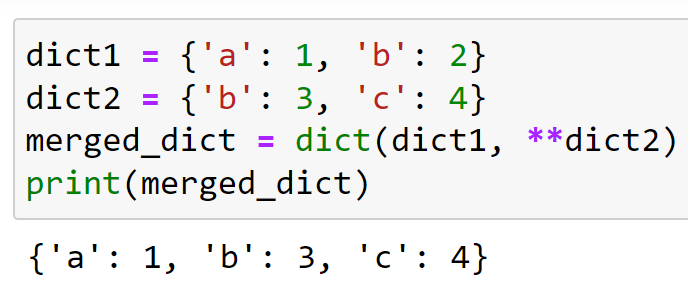
In this case, we’re creating a new dictionary merged_dict that combines the values from both dict1 and dict2.
This method does not modify the original dictionaries, unlike the update() method. With this method, you can even merge two or more dictionaries.
3. How to Merge Dictionaries With the Unpacking Operator
In Python, one way to merge dictionaries is by using the unpacking operator. The unpacking operator ** allows us to expand the contents of one dictionary into another.
Essentially, it turns the key-value pairs of a dictionary into keyword arguments, which can then be used to update or merge dictionaries.
The following is an example of merging Python dictionaries with the unpacking operator:

Here, we have two dictionaries dict1 and dict2, and we want to merge them into a single dict class dictionary merged_dict.
By using the unpacking operator, we can easily accomplish this.
Note how the value of ‘b’ is updated to 3, which is the value from dict2.
4. How to Merge Dictionaries With the Merge Operator
The merge operator | is an efficient method that allows you to merge Python dictionaries.
This operator, introduced in Python 3.9, performs a union of two dictionaries, where if a key exists in both dictionaries, the value from the second dictionary will overwrite the value from the first.
The below example illustrates merging dictionaries with the merge operator:
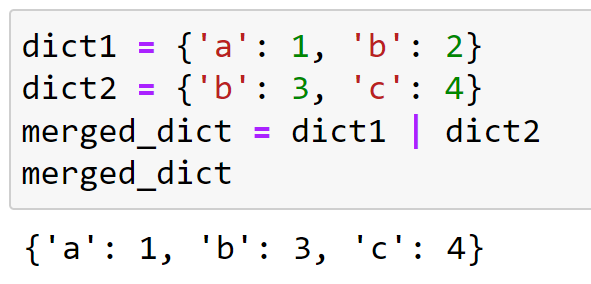
5. How to Merge Dictionaries With Dictionary Comprehension
Dictionary comprehension is a powerful and convenient method that can be used to merge multiple dictionaries by iterating through their key-value pairs.
This technique can handle overlapping keys and even custom merging rules.
The following is an example of merging dictionaries with dictionary comprehension:
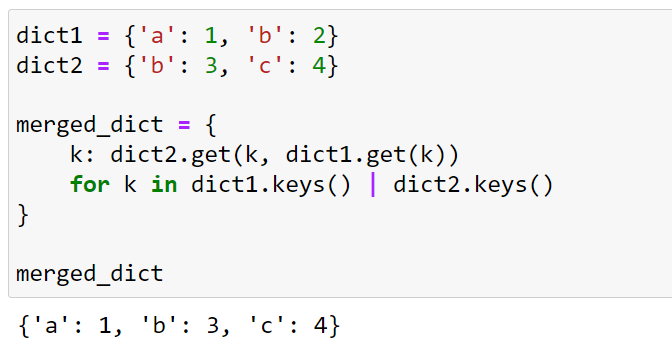
In the code above, we use dictionary comprehension with a for loop to iterate through the union of the keys in both dictionaries.
The get() method allows us to handle missing keys efficiently and merge the dictionaries according to our desired rule.
6. How to Merge Dictionaries With ChainMap
ChainMap is a class available in Python’s collections module, providing an alternative way to merge dictionaries.
This class creates a single view of multiple dictionaries without merging them, making it an efficient option to combine dictionaries without modifying the original data.
The following is an example of merging dictionaries with ChainMap:
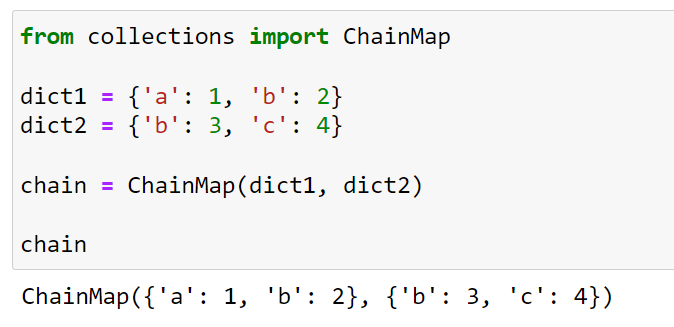
It’s important to note that ChainMap follows a left-to-right order when looking up keys.
If a key exists in multiple dictionaries, the value from the first dictionary containing that key will be returned.
7. How to Use Functions for Merging
You can also use functions for merging dictionaries in Python. The **kwargs syntax enables dictionary unpacking within a function, making it a powerful tool for merging purposes.
First, let’s delve into a simplistic method that involves extending the base function with additional keyword arguments.
In this case, you can use the extend() method to implement merging directly:
def merge_dicts(d1, d2):
d1.extend(d2)
return d1However, it’s essential to note that extend() is not a native Python method for dictionaries. This approach requires further attention to avoid potential issues.
Another method of merging dictionaries using keyword arguments is to utilize a function that accepts **kwargs for the input. This allows us to collect all specified keyword arguments in a new dictionary.
Here’s an example in one line of how it can be done:
def merge_dicts_function(**kwargs):
merged_dict = {}
for key, value in kwargs.items():
if key not in merged_dict:
merged_dict[key] = value
return merged_dict
merged_dict = merge_dicts_function(**d1, **d2)
In this example, the d1 and d2 syntax helps unpack the contents of the input dictionaries, making it possible to merge both dictionaries efficiently.
The resulting merged_dict will store the merged values from the original dictionaries.
Final Thoughts
As you continue your journey with Python, mastering the concept of merging dictionaries can be a pivotal step. It streamlines your data manipulation tasks, making them quicker, cleaner, and more efficient.
Whether you’re dealing with configurations, user data, or inputs for your functions, merging dictionaries allows you to interact with multiple data sources seamlessly.
This technique also allows you to condense information, reduce redundancy, and optimize your code.
As your programs grow in size and complexity, you’ll find that this ability to create and combine dictionaries elegantly can be a lifesaver.
To learn more about how to use Python to do different tasks, check out the playlist below:
Frequently Asked Questions
In this section, you’ll find some frequently asked questions that you might have when working with dictionaries in Python.

How can I merge two dictionaries in Python?
To merge two dictionaries in Python, you can use the update() method or dictionary unpacking.
In Python 3.5 or greater, you can merge dictionaries like this:
z = {**x, **y}For earlier versions, you can use the update() method:
x.update(y)What is the best way to combine multiple dictionaries?
The most concise and efficient way to combine multiple dictionaries is to use the dictionary unpacking method in a single expression.
For example:
z = {**d1, **d2, **d3}How to concatenate dictionaries with the same keys?
When dictionaries have the same keys, you can concatenate their values by iterating through the keys and appending the values:
z = {k: x.get(k, []) + y.get(k, []) for k in set(x) | set(y)}How do I update a dictionary with another one?
To update a dictionary with another one, you can use the update() method, which adds key-value pairs from the second dictionary to the first:
d1.update(d2)How to sum values of common keys in merged dictionaries?
To sum the values of common keys in merged dictionaries, you can use a dictionary comprehension:
z = {k: x.get(k, 0) + y.get(k, 0) for k in set(x) | set(y)}







